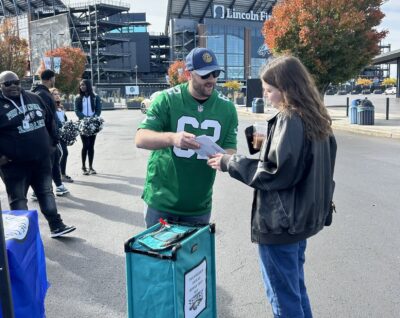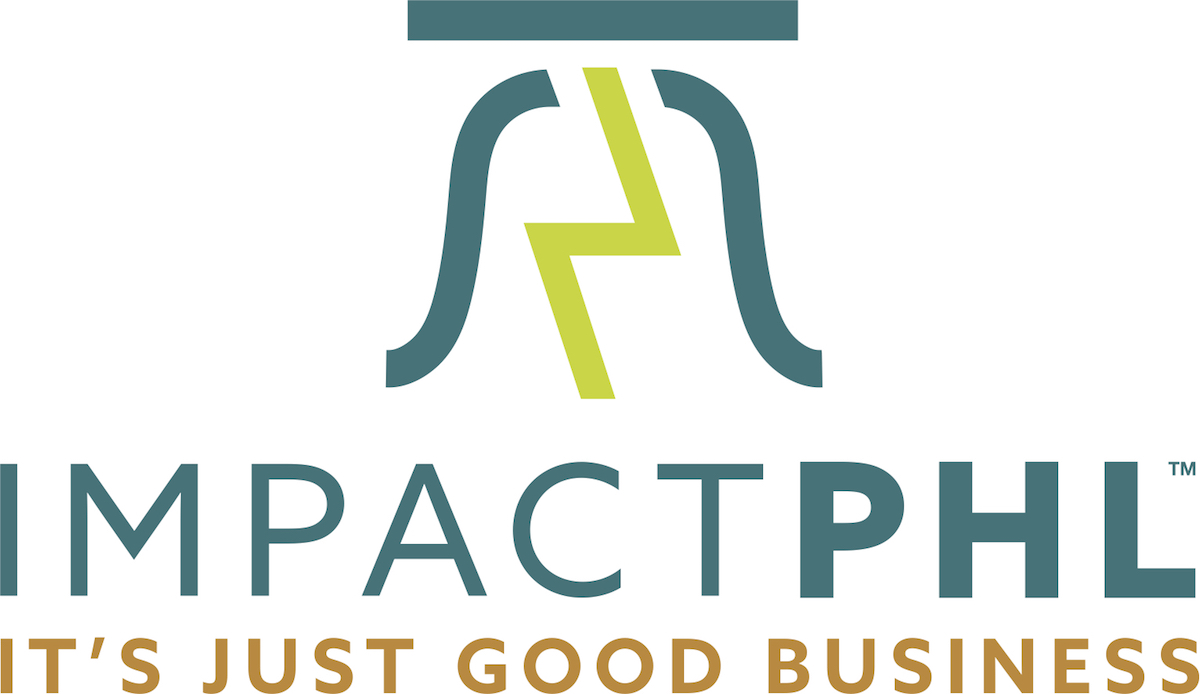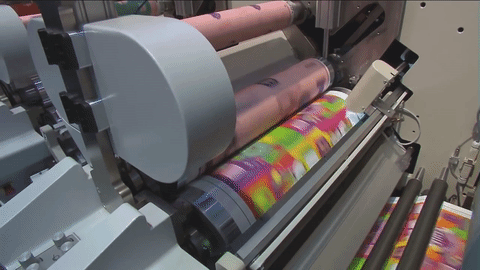What future do you imagine for the Greater Philadelphia region?
When we ask this question, responses touch on everything from climate resiliency to racial justice, eliminating poverty to greater health equity. While the answers are varied, they boil down to a common core: People want well-being for themselves, family, neighbors, communities, our region, and our planet.
Today, it’s often hard to imagine how we’ll move closer to that reality tomorrow, let alone years and decades to come. In the 2020s alone, COVID-19 has shaken our public health, racial injustices continue to harm communities, we’ve experienced extreme weather in our backyard, and our local economies have taken an incalculable hit. Individuals and institutions alike are trying to reconcile how to move forward from this present moment — using tools from volunteering to investing, protesting to policy change — toward a brighter future.
The hard news? Our position is daunting, complex, and requires a hard look at the old systems and tools that got us here. The good news? Leaders across Greater Philadelphia are already kicked into action (and, in some cases, have been for years), modeling new paths forward that will only progress as more and more people bring their invaluable time, talent, energy, and — importantly — money.
Why it’s time to move money in new ways
When ImpactPHL launched in 2016 (we turned five this year!), we started on a mission to accelerate Greater Philadelphia’s impact economy. Since then, the “why” behind our work has only grown more significant and urgent — through both anticipated and unforeseen turns on the journey.
Behind local challenges — the Vine Street expressway turning into a river or Philadelphia’s pervasive poverty — is an economic system that has prioritized profits over people and the planet for far too long. Capitalism that supports investing and doing business to make money (without regard for harm created or resources extracted), then only donating or “giving back” a fraction of profits/returns to try to fix the harm is not just or sustainable.
The consequences of this approach are that problems are created at a far faster rate than government, philanthropy, and nonprofits can solve. The implications are countless, deep, and far-reaching — directly impacting our own lives, as well as the people and places we love.
Consider multi-million or billion-dollar companies damaging our natural environment, while much smaller philanthropies and nonprofits advocate and fund solutions. Consider the one out of five Philadelphians who face food insecurity, who benefit from food banks and community fridges, but will not achieve security if community disinvestment or fair wages aren’t addressed. Or, consider social justice advocates who donate to local recidivism initiatives but whose 401(k)s are unknowingly invested in private prisons.
ImpactPHL advocates economic systems change, shifting how we think about and invest money. What began as an alliance five years ago became an initiative incubated by Ben Franklin Technology Partners, and into what ImpactPHL is today: a young, growing nonprofit supporting individuals and institutions that are investing in solutions to create a more equitable, sustainable, and resilient Philadelphia region.
While we’re proud of what our small team and its partners have been able to accomplish, we’re even more proud of what our entire, fellow regional impact investing community has — and continues to — accomplish together.
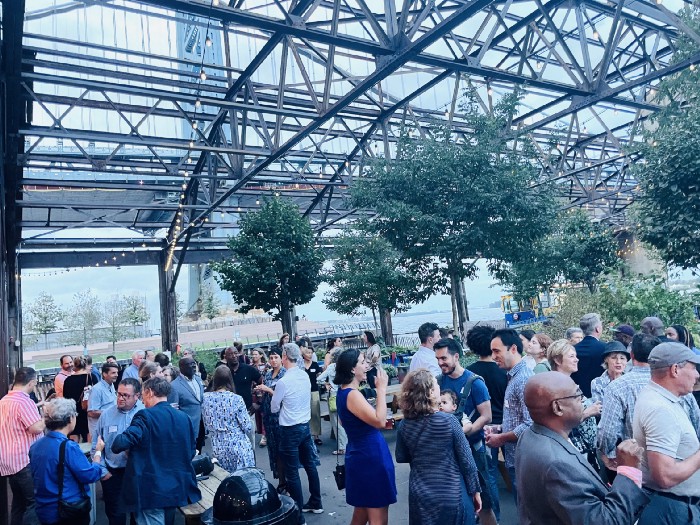
ImpactPHL supporters gather at Cherry Street Pier, September 2021. (Courtesy photo)
15 signals Greater Philadelphia is headed in the right direction
As ImpactPHL marks our five-year anniversary, we wanted to share 15 signals we believe indicate Greater Philadelphia is carving a path forward, connecting a growing impact investor community with local investable opportunities — and showing that Philadelphia is poised to be a leader in the U.S. impact investing landscape.
###
Impact investing relies on investors thinking about and moving their money in new ways. ImpactPHL supports this work through hundreds of one-on-one conversations with investors and investment professionals — including high-net-worth individuals, foundations, family offices, wealth advisors, fund managers, and more. We convene, connect, and educate investors through monthly programming, socials, and our annual flagship conference.
1. High-net-worth individuals are thinking differently.
Local high-net-worth individuals are examining their assets, rethinking the divide between investments and philanthropy, and looking in their backyard for deal flow. They’re joining networks like Social Venture Circle, a membership community of angel impact investors whose Greater Philadelphia chapter has invested over $20 million and catalyzed over $80 million in private, early-stage debt and equity investments into local projects like First Step Staffing (a $6 million investment resulting in over $50 million in earned wages paid to local individuals experiencing homelessness) and Jeffery Miller Catering (a $1 million investment with a projected 3.3x impact multiple that will increase revenue for local nonprofits).
2. Investors are lending and investing dollars with crowdfunding.
Accredited and non-accredited investors alike are pooling investments for local opportunities raising capital on crowdfunding platforms like Wearwell’s $100,000 raise from 221 investors on Republic to curate conscious clothing or InnaMed’s $1.2 million raise from 1,390 investors on Wefunder to advance at-home blood testing technology
3. Established institutional investors are aligning funds for impact outcomes.
Ben Franklin, one of the country’s leading seed-stage investors and a critical local economic development institution, launched ImpactPHL Ventures — a $17 million capital collaborative. Investment partners — including Social Venture Circle, Temple University, Spring Point Partners, Independence Health Group, the Bucks County Retirement Board, MontoCoMade Investment Initiative, Chester County, and StartupPHL — have invested in 53 local solutions, including Astarte Medical which uses data to improve infant outcomes and Roundtrip which provides transportation solutions to increase health access.
4. Foundations are moving beyond grantmaking.
The Philanthropy Network of Greater Philadelphia conducted an impact investing landscape scan that reported 69% of investors want to understand more about impact investing, and they now host an ongoing mission-aligned investing group for peers to co-learn. Foundations like The Patricia Kind Family Foundation achieved 100% mission alignment with their $35 million corpus, joined by other pioneers like Tara Health and Spring Point Partners that are taking significant strides to align investments for local impact.
5. Trusted intermediaries are integrating impact.
Long-standing intermediaries that serve local capital providers, like PACT and the Economy League of Greater Philadelphia, have adopted impact-focused approaches by incorporating impact into their annual conference and launching programs like Impact Labs, respectively.
###
Investing for impact outcomes in Greater Philadelphia requires the existence and visibility of local, investable opportunities across asset classes. ImpactPHL supports the connection of investors to a pipeline of opportunities through initiatives like our Greater Philadelphia Impact Investing Index, monthly investor briefing, and North Philly Impact Trolley Tour. Further, we’ve demystified what local impact investments look like through a series of local case studies.
6. Local, for-profit social enterprises are raising millions.
Social enterprises — such as Simply Good Jars, Triple Bottom Brewing, and ROAR for Good — have raised millions in capital from both local and national investors to address everything from clean energy to women’s health, sustainable supply chains to recidivism.
7. Real estate initiatives are invested in equitable development.
Initiatives across the city — like Shift’s Neighborhood Fund and Kensington Corridor Trust, Mosaic’s Sharswood project, TPP Capital’s Healthytown, and The Collective’s Real Estate Impact and Equity Fund — have and are currently raising hundreds of millions to transform neighborhoods that have been historically underserved with community-driven and led development.
8. Local development finance institutions accept investments for regional capital deployment.
Investors can ensure their money has a local impact with Greater Philadelphia’s strong network of Development Finance Institutions (DFIs) and Community Development Finance Institutions (CDFIs). For example, one can invest in The PhilaImpact Fund from S&P A+ rated Reinvestment Fund, a Promissory Note from Community First Fund, The Enterprise Center to serve local, minority-owned businesses, or in Ben Franklin Technology Partners to advance tech-empowered impact.
9. New investment funds will increase capital access for underserved entrepreneurs.
New investment funds — Plain Sight Capital and Innovate Capital Growth Fund — address the equity investment gap for underserved entrepreneurs and are led by well-known leaders with local track records including Sylvester Mobley of Coded by Kids and Della Clark of The Enterprise Center.
10. Local anchor institutions and corporations are cultivating aligned, local impact pipelines.
From Campbell Soup Company to Children’s Hospital of Pennsylvania, local institutions are working to cultivate a pipeline of investable opportunities through initiatives like the Fair Food Fund and Philadelphia Anchors for Growth & Equity (PAGE). PAGE Capital — the capital-focused leg of the PAGE program — launched The Hurdle Fund, a philanthropic grant pool capitalized by local impact investors that will eliminate barriers local Black and brown-owned businesses face in pursuing new and larger anchor contracts to grow their businesses and build wealth.
###
Growing the ecosystem requires activities like advocacy, connecting dots, and storytelling. ImpactPHL supports the visibility of the local impact investing ecosystem by building partnerships, creating an ambassador program, offering platforms like the Total Impact Conference and ImpactPHL Perspectives series, serving as a resource to media, and more.
11. World-class convenings are coming to Philadelphia.
SOCAP Global, the largest convener of global impact investors, partnered to bring their Total Impact Conference to Philadelphia in 2018, then again in 2019, convening hundreds from across the country on impact investing practices and place-based examples
12. National investment initiatives are choosing the Philadelphia region.
National level funds and capital initiatives — like the Founders First Fund, Backstage Capital, Village Capital, and BII Fund-Building Cohort— have chosen the Philadelphia region as a geography for action and capital deployment
13. Media outlets recognize the value of impact investing.
Local and national media outlets alike, including the Philadelphia Citizen and Impact Alpha, are reporting on Philadelphia’s impact investing ecosystem in articles like “Equity to End Inequity” and “Philadelphia’s impact investors step up to finance local job-creation.” Even The Philadelphia Inquirer is picking up on why major local institutions must shift their investments in articles like “Million dollar investments from Penn, the city, and William Penn Foundation push us closer to climate crisis.”
[Editor’s note: Us, too!]
14. Global networks are growing local community cohorts.
Networks — such as Women Investing for a Sustainable Economy and Impact for Breakfast — have a local presence, partnering to convene the community, connect peers, and share educational content
15. Thought leaders & practitioners share to accelerate learnings.
Forty-five contributors have authored thought-leadership and educational pieces for ImpactPHL Perspectives on topics ranging from Employee Stock Ownership Plans (ESOPS) to investing in CDFIs, health care access to investing in minority entrepreneurship.
No slowing down: The road ahead for Greater Philadelphia impact investing
Globally, impact investing shows no signs of slowing down. In the five years since ImpactPHL launched, leaders like Larry Fink with BlackRock (the world’s largest asset manager) have said “I believe we are on the edge of a fundamental reshaping of finance,” while the Business Roundtable redefined the purpose of a corporation to serve all stakeholders, not just shareholders. As minds are shifting, so too are dollars. The impact investing market grew from USD $15.6 billion in 2016 to USD $715 billion in 2020 and is seeking to capitalize solutions.
Regionally, Greater Philadelphia faces both a significant need and significant opportunity. We must address the root causes of complex challenges that have hindered our region for decades, are emerging today, and could arise unforeseen in the future. The opportunity cost of not solving or building resiliency for challenges like poverty, equitable education, or climate change is immeasurable — for the health of our economy certainly, but most importantly, for the lives of all who live here.
At the same time, Greater Philadelphia has significant advantages — from our world-class “eds and meds” to generational loyalty and pride — that offer a foundation of strength for growing the impact ecosystem we’ve outlined above, increasing the flow of investment dollars into our region (from local, national, and global investors), measuring impact outcomes, and watching our region move toward its full potential.
ImpactPHL’s role is to build upon the foundation of our last five years into our next five, supporting the growth of the local impact investing community, visibility of investable opportunities, and strength of the ecosystem at large. We aim to continue listening, learning, testing, and honing the value that we provide in service of our mission and the place we call home.
Are you ready to (literally) invest here and help create the future we want for our region? If you’re interested in participating in the local impact economy, working with ImpactPHL, or supporting our work, we invite you to get in touch. Email ImpactPHL’s executive director, Cory Donovan, to set up a conversation. In the meantime, stay up to date on everything Greater Philadelphia impact investing by signing up for our newsletter and following us on LinkedIn.
Before you go...
Please consider supporting Technical.ly to keep our independent journalism strong. Unlike most business-focused media outlets, we don’t have a paywall. Instead, we count on your personal and organizational support.
Join our growing Slack community
Join 5,000 tech professionals and entrepreneurs in our community Slack today!

Trump may kill the CHIPS and Science Act. Here’s what that means for your community.
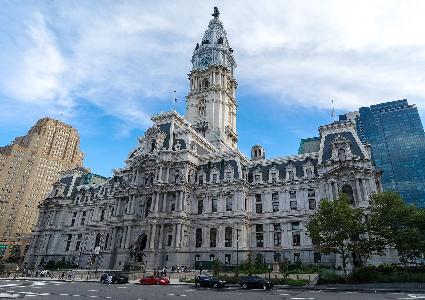
A week before Election Day, some Philly city employees question unexpected website change
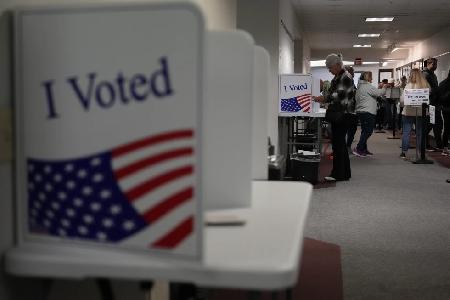
A Pennsylvania voter’s guide to tech policy on the ballot in the 2024 election
